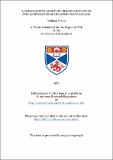Files in this item
A comparative study of proprioception in the appendages of decapod crustaceans
Item metadata
| dc.contributor.advisor | Laverack, M. S. | |
| dc.contributor.author | Wales, William | |
| dc.coverage.spatial | v, 169 p. | en_US |
| dc.date.accessioned | 2018-06-26T16:49:06Z | |
| dc.date.available | 2018-06-26T16:49:06Z | |
| dc.date.issued | 1971 | |
| dc.identifier.uri | https://hdl.handle.net/10023/14645 | |
| dc.description.abstract | The number and structure of the chordotonal organs present at all joints between the coxopodite and dactylopodite of the pereiopods and 3rd maxilliped of the Macruran gammarus L are described. As the form of the receptors depends to some degree upon the structure of the joint I have included details of musculature, planes of movement and degrees of freedom at each joint. 2 The 3rd maxilliped has a smaller number of chordotonal organs than the pereiopod, in particular at the merocarpopodite and cargo-propodite joints where only one organ is present. The response of these receptors shows considerable differences from the corresponding receptors in the pereiopoth 3. The structure of the carpo-propodite joint of both limbs is discussed in detail as this joint differs greatly from that of the Brachyura as a third muscle is present. In the pereiopod this joint is capable of rotation about the longitudinal axis but the additional muscle does not appear to produce this rotation. A small number of units in the CP2 receptor respond to rotation. 4. Cuticular sensilla (CAP organs) are described at the mero-carpopodite and carpo-propodite joints in both limbs and at the I-N joint of the pereiopod. 5. Situated in the basi-isehiopodite of the brachyuran Carcinus maenas are two receptors which resemble the chordotonal receptors of the limb articulations but are obviously not part of the series associated with the joints. The receptors have large numbers of bipolar neurones with their dendrites embedded in distinct connective tissue strands which insert onto discrete areas of thin or soft cuticle. The receptor strands do not span a limb joint nor do they attach to a muscle or its tendon. The receptors are referred to as cuticular stress detectors (CSD). CSD.1 lies proximal to the preformed breakage plane and the area of cuticle, onto which the strand inserts, lies close to the attachment of the anterior levator muscle tendon (autotomiser muscle). CSD.2 which lies distal to the breakage plane is located in the ventral ischiopodite. 6. Because of the proximity of the receptors to the preformed breakage plane the external cuticular features of the basi-ischiopodite and the musculature of the coxo-basipodite joint are described in some detail. 7. Comparative details are given for representative species of the Macrura and Anomurn. The nephropsideans, Macrura, are particularly interesting as only the 1st pereiopod, chela, exhibits true autotomy but both receptors are present in all the pereiopods. 8. A third group of bipolar neurones is described in Palinurus vulgaris where they innervate the membrane that seals the aperture after breakage. 9. The dual role of the two levator muscles in both posture control and autotomy and possible functions of the CSDs are discussed at length. 10. The CSD organs respond to pressure applied to the basi-ischiopodite and upon deformation of the discrete areas of soft cuticle onto which the connective tissue strands of the receptors insert. The CSDs exhibit a wide range of unit activity and both receptors have a similar population of unit types. Some units are active only on application or removal of a force applied to the soft cuticle but a large number of phaso-tonic and tonic units respond to a constant pressure applied to the soft cuticle. The majority of the units respond during application of the stimulus (ON units) but a small proportion of the units increase activity on removal, of the stimulus (OFF units). 11. Passively produced tension in the anterior levator (autotomiser) muscle and depressor muscle tendons of the C-B joint is a potent stimulus to both receptors. 12. Both receptors respond to movement of the B-I joint of the Nephropsidean walking leg and to movement of the I-M joint in the pereiopods of other reptantian decapods where the basipodite and ischiopodite have fused. The degree of activity is not directly related -to the joint position or direction of movement. | en_US |
| dc.language.iso | en | en_US |
| dc.publisher | University of St Andrews | |
| dc.subject.lcc | QL444.D3W2 | en |
| dc.subject.lcsh | Crustacea | en |
| dc.title | A comparative study of proprioception in the appendages of decapod crustaceans | en_US |
| dc.type | Thesis | en_US |
| dc.type.qualificationlevel | Doctoral | en_US |
| dc.type.qualificationname | PhD Doctor of Philosophy | en_US |
| dc.publisher.institution | The University of St Andrews | en_US |
This item appears in the following Collection(s)
Items in the St Andrews Research Repository are protected by copyright, with all rights reserved, unless otherwise indicated.

